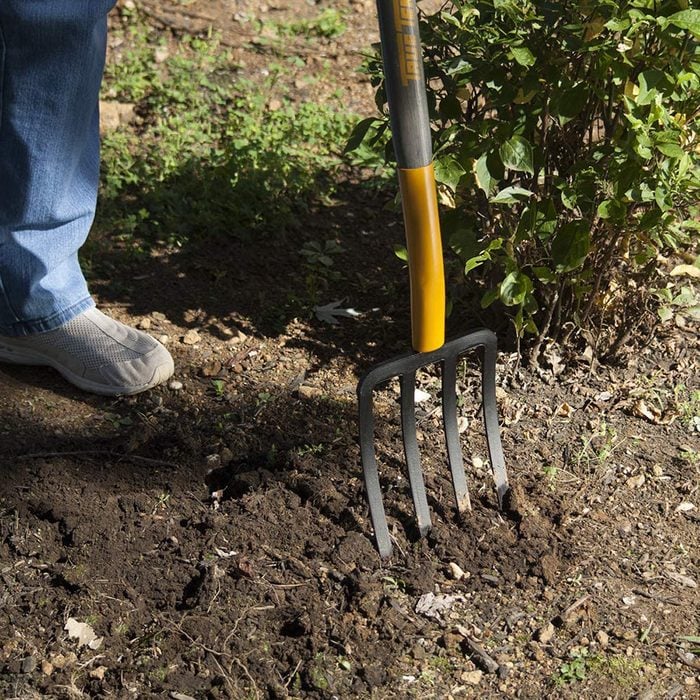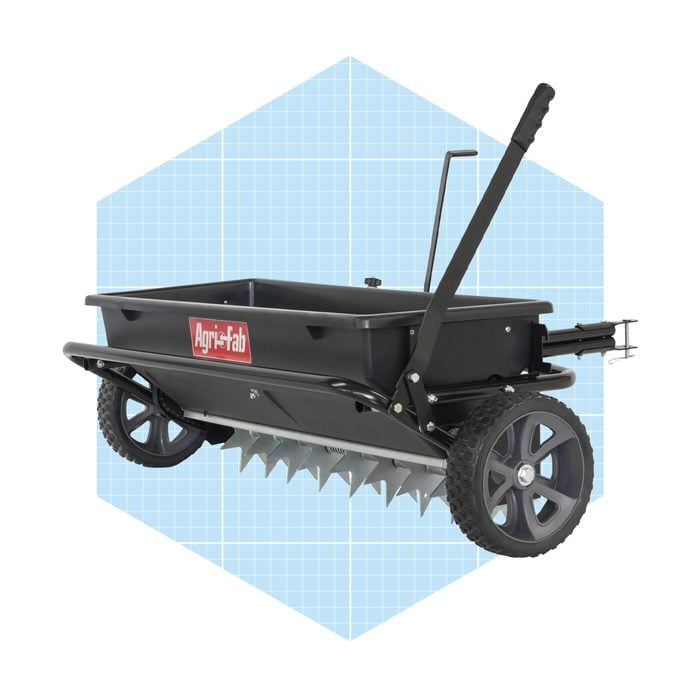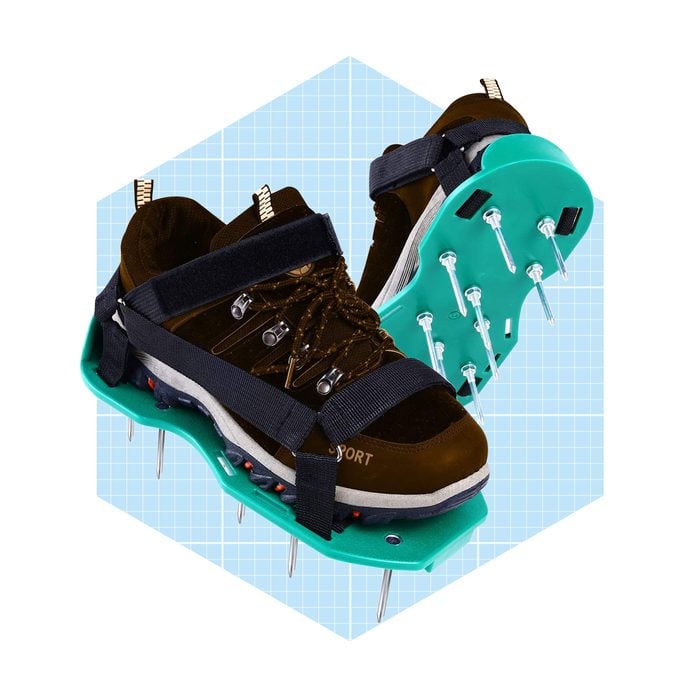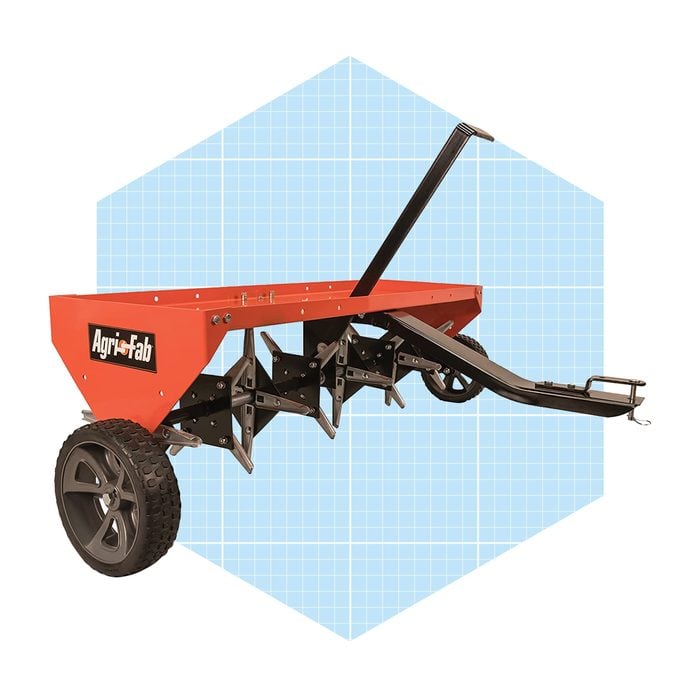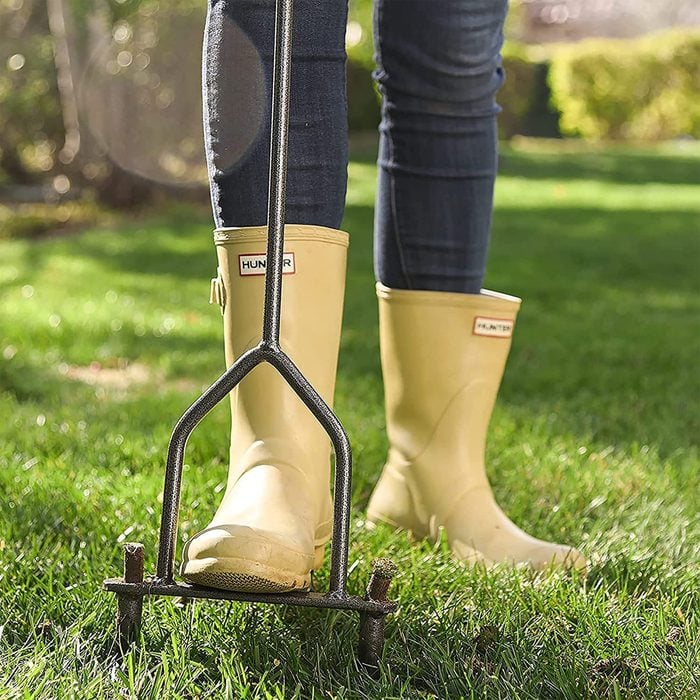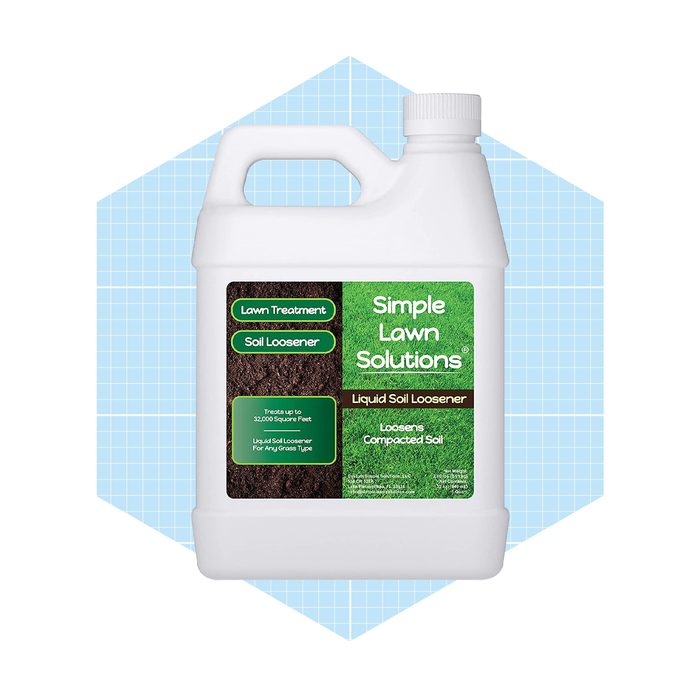 VIA MERCHANT
VIA MERCHANT
The Simple Lawn Solutions Liquid Soil Loosener is an easy alternative to manual or mechanical aerators. It treats the soil, breaks down the thatch, reduces compaction, and promotes water drainage and filtration as it softens the lawn. Whether you want to use this loosener in tandem with other aerators or on it’s own, it’s sure to impress. Oh, and did we mention it works on all grass types? Consider us sold.
Pros
- Can be used alone or with mechanical or core aerators
- 32-ounce bottle covers up to 32,000 square feet
- Safe to use on all types of grass
- Made in the USA
Cons
What to Consider When Buying a Lawn Aerator
There’s much to consider before getting your first lawn aerator. Can you handle the physical task of operating a manual aerator over a gas- or electric-powered option? If you own a lawn tractor or riding lawnmower, a tow-behind lawn aerator might be the way to go. Do you prefer plug- or spike-style aerators? How much are you willing to spend? How much storage space do you have in the garage or shed to store the aerator? These are all important questions to ask yourself before purchasing a lawn aerator of any kind. We’ve parsed through the considerations more in-depth below:
Ease of Use
Dr. May states, “Aerators are fairly simple machines to use, but they do require skill to operate.” While simple in concept, they can be heavy and potentially damaging to your turf should you turn the machine poorly, overdo (or underdo) the job, etc. While hand-operated aerators are sometimes more painstaking to use (due to their manual nature), they do allow for more care and precision than their larger counterparts.
Size of the Job
Are you trying to aerate a small patch of grass or a whole yard? For the former, a smaller, hand-operated aerator is probably fine. But the latter might necessitate a larger option, like a tow-behind mower.
Cadence
Dr. May suggests that “most lawns will benefit from a yearly aeration.” Since this is going to be a project you take on annually, you’ll want to make sure your aerator of choice is up for the task—and that you’re not going to be frustrated by it, too. This kind of goes hand-in-hand with the size consideration above in that an aerator that can handle bigger jobs might help alleviate your stress when you actually have to use it.
It’s also worth noting that different types of lawns will benefit from aeration at different times of year. Warm-season grasses are best aerated from May to August, whereas cool-season grasses benefit most in the early spring and late fall.
Lawn/Yard Quality
If your lawn is particularly swampy, aeration probably won’t do you much good, as any holes you make in the soil will likely fill with mud. Similarly, an overly dry lawn will have hard soil that’s difficult to penetrate, so it will not see much in the way of benefits and may require a lot of backbreaking work. If your lawn is in either of these extremes, you may wish to consult a professional to get their opinion on the matter before doing any work.
Benefits of Aeration
You might think this seems like a lot of work for little payoff, but myriad benefits to aerating your lawn could keep your yard healthy and looking great year in and year out. As Dr. May informed us, aeration helps with soil compaction, thatch management, increased nutrient availability and balancing the soil’s pH and can even lead to a thicker, healthier lawn. And who doesn’t love a good, healthy lawn in the warmer months of the year?
Professional Help
You don’t have to buy a lawn aerator to keep your lawn healthy. You can always hire landscapers to do the job. Keep in mind, however, that this will cost you more overall, especially if you want your lawn regularly aerated (and the pros say you should be doing it at least once a year). It’s also worth noting that a professional job comes with professional results (especially if your contractors are reputable), so that’s also worth considering.
Types of Lawn Aerators
Lawn aerators come in different varieties. Check them out below:
Manual/Handhelds
The most basic type of aerator requires the user to fully operate the tool by hand. They may be static (like a pitchfork) or wheeled (like a push lawnmower). They can be very physically demanding but are usually the most affordable option. If you don’t mind the manual labor, this category is probably the best bang for your buck.
Aerator Shoes
Aerator shoesare wearable cleats you attach to your regular shoes, usually with spikes on the bottom that dig into the soil beneath your feet to aerate your lawn. While they are more convenient than manual/handheld aerators, they may also be less efficient. They can acquire a soil buildup as you use them, forcing you to frequently clean them off as you use them (and thereby undoing some of their proposed convenience).
Tow aerators
These can be pulled behind your lawn tractor or riding lawnmower. Think of them as larger versions of push-mower-style manual lawn aerators. The downside is that they can be quite expensive and take up a lot of space (and you’ll need dedicated storage to keep one on your property). However, they are highly efficient and very easy to use, as your tractor or mower will do most of the work.
Gas- or electric-powered models
Typically, the largest lawn aerators tend to be multi-taskers that not only make holes but also sow seeds and spread fertilizer at the same time. They’re also by far the most expensive version, both in their initial cost and their operation cost and upkeep. This is the kind of aerator you’ll only want if you have frequent, sizeable jobs—like a farmer might. Remember that an electric model will require a constant connection to a power source (a cable plugged into an outlet), while gas-powered options offer a bit more freedom. There are also cordless versions, which offer much freedom but usually have long charging times.
Liquid Aeration
Liquid aeration is an easy-to-use fortified solution that breaks down soil particles. There are pros and cons to this method. It’s fairly easy to manage and requires virtually no manual labor, comparatively (you simply spread an organic chemical mixture over your lawn and wait). But it is not as immediately effective as mechanical aeration, and it may be even less effective if your soil is particularly compacted. However, it may be an ideal solution for those with relatively small lawns who don’t mind a higher overall price in favor of simplicity/ease.
How We Found the Best Lawn Aerator
There’s a lot to consider when searching for the best lawn aerator, so we took a top-down look at the category, starting with the range of brands in the space with solid reputations. Then, we closely examined the range of available lawn aerators—including their formats (manual, tow, electric, etc.), size, price, etc.—and further narrowed down our range of options. Finally, we consulted experts and researched the customer experience to ensure our final list was comprised of various formats and budgets but still met our expectations for quality, durability and reliability.
Why You Should Trust Us
After a decade in the DIY and furniture space, I parsed my expertise into a successful writing career, specializing in home improvement (both inside and out), DIY, landscaping and garden, outdoors and camping and more. I have also been published in an array of time-tested, trustworthy publications, including The Telegraph, Fodor’s, Italy Magazine, DK Eyewitness Travel Guides, Orvieto or Bust, and Family Handyman.
For this article, I also consulted Dr. Roger May, the Michigan Region Technical Manager for TruGreen—responsible for overseeing operations in 16 branches across Michigan and developing horticulture and agronomic programs for the state. He also tests innovative new products and trains TruGreen employees in advanced lawn care practices and agronomic science at the TruExpert Certification Program.
FAQ
When should I aerate my lawn?
The optimal time to aerate your lawn is late summer or early fall. This time of year, lawns are most compacted, so aeration helps alleviate tamped-down soil and prepares it for the grass-growing season. After a rainfall, it is a great time to aerate since the ground is soft, allowing for deeper penetration with less effort. We recommend avoiding aerating during the hot summer months, which will only dry out and put undue stress on your lawn.
Do I need to cut my grass before aerating my lawn?
It’s unnecessary, but mowing the grass down to a few inches will maximize the lawn aerating effectiveness.
Do holes fill in after aeration?
Yes. New grassroots will fill in holes left behind after aerating the lawn within a week or so.





















